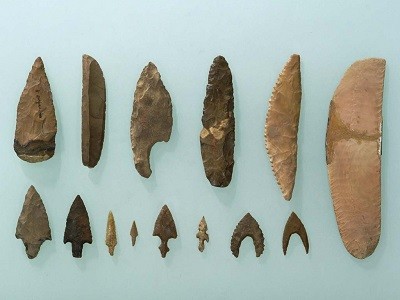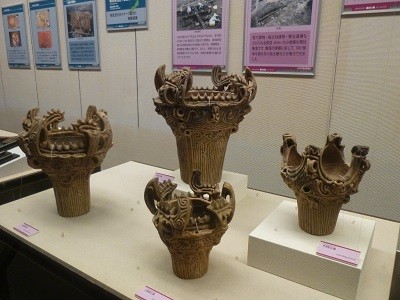The Jomon Period is the first-named period in Japanese history. This period comes after the last glacial period and old stone age. The Jomon Period started about 70,000 years ago and lasted until 10,000 years ago, at which point the Yayoi Period began. What was going on in prehistorical Japan?
Before the Jomon Period
The Last Glacial Maximum
Around 21,000 years ago was the last Ice Age, called the Last Glacial Maximum. At that time, the amount of seawater was greatly reduced and the water level lowered about 120 meters. It is said that all four major islands of Japan were connected and that they were also connected with the Eurasian Continent and Sakhalin Island. After this Ice Age, the globe started to warm up rapidly and the warming temperature changed the atmosphere dramatically.
Old Stone Age
The Old Stone Age was just before the Jomon Period. The characteristic of this period is that the people used chipped stone tools which were not polished. The chipped stone was used as a hand ax, a blade for cutting and whittling, and as the point of an arrow or spear.

They lived in caves and made a living by hunting and collecting plants and nuts. The bones of Naumann elephants and Sinomegaceros yabei (a kind of big elk) from this period were found in Japan.
New Stone Age
The Jomon Period is regarded as the New Stone Age. People started using polished stone tools. What’s significant is that they started producing earthenware with special decorations like rope patterns. The name ‘Jomon’ literally means ‘rope pattern’. The people still made a living in a hunter-gatherer economy, but they slowly started domiciliation by building residential constructions using logs and leaves.
Jomon Period Residences
Residences at that time were pit-dwellings. People dug shallow pits in the ground that functioned as protective homes. The average depth was 60 to 70 cm, but the pits in cold Hokkaido were about 2.5m deep. The average surface was 20 to 30 m2. Some were square-shaped and some were round.
They made a ditch along the circumference for drainage. 4 – 6 wooden pillars and framework were used for sturdiness. The whole house except the entrance would be covered with leaves, branches, or bark. The Jomon people cooked food using fire in their homes.
Besides the residences, they also made high-floor constructions. In the Yayoi Period that followed the Jomon Period, these were used to store rice. But during the Jomon Period, it is believed they were used as temples to hold rituals.
Sannai Maruyama Special Historical Site
There are hundreds of ruins from the Jomon period all over Japan, but the Sannai Maruyama Special Historical Site in Aomori is one of the best examples.



This is the actual site of a former large-scale village from 5,900 BC to 4,200 BC. It was already found during the Edo period (1603-1867). They excavated many earthen dolls, tiles, and ceramic pots. The full-scale excavation started in 1992 when there was a plan to make a baseball field at the site. After they found even more artifacts of the Jomon period, they stopped the construction of the baseball field and started site preservation. They found out that the site is about 400,000 m2 large.
You can see a residential area with pit-dwellings. The biggest house is 32m x 10m. Another area has high-floored constructions. There is no evidence of everyday life there. There is also a symbolic three-storied pillar tower. They restored the construction, but we are not sure what it really looked like. There is also a stone circle. It is believed that this was the graveyard of the village masters.
Access: 15 minutes by bus from JR Shin-Aomori station or 30-40 minutes by bus from JR Aomori station. It takes about 3 hours from Tokyo to Shin-Aomori by Shinkansen.
Fee: 410 yen for adults / 200 yen for university and high school students
Hours: 9 am – 6 pm (June to September) / 9 am – 5 pm (October to May)
*Closed on each fourth Monday
The Jomon Period in the Tokyo National Museum
If you go to the Tokyo National Museum, you can see many excavated items from the Jomon period. Some are exhibited in the main building as a part of the permanent exhibition. Some are exhibited in the Heisei-kan pavilion as a part of the archaeological exhibition. You can see Jomon earthenware that bears the characteristic rope patterns. Some of them look like a flame. There are also earthen dolls on display.

Access: 10-minute walk from Ueno Station (JR and Tokyo Metro)
Fee: 1,000 yen for adults / 500 yen for university students / free for under high school students. If you want to see the special exhibitions, you need to pay extra. The price depends on the exhibition.
Hours: 9.30 am – 5 pm (closed on Monday)
Your Japan Tour
As seasoned Japan experts, we can help you create your perfect Japan tour including guides who can tell you all about Japanese history including the Jomon period. The guide can take you to the sites related to the period if you wish. Check out our group tours and private tours, or contact us to start planning your unforgettable holiday to this fascinating country full of once-in-a-lifetime experiences, culture, history, nature, and delicious food!

